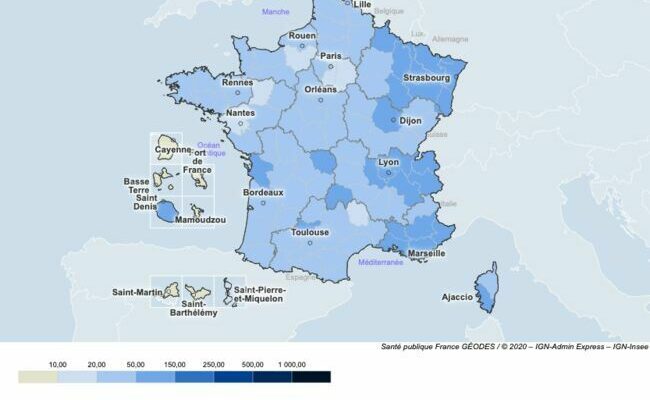“COVID-19 activity was up slightly in community medicine and hospitals, particularly among those aged 65 and over”, observes Santé Publique France in its latest weekly epidemiological bulletinpublished on December 6, 2023.
While cases of bronchiolitis are not decreasing and the flu virus is also circulating, health authorities are calling for caution and recalling the importance of vaccination for the most vulnerable. “In this context and in view of family gatherings for the end of year holidays, it is essential that people at risk protect themselves by vaccinating against seasonal flu and COVID-19 and that everyone continues to adopt barrier gestures.”
How to explain this return of Covid? The return of cold indirectly means that you spend more time in closed, confined and less well ventilated places. Other respiratory viruses are also progressing at the start of December, like RSV (the bronchiolitis virus), the flu which is starting in France (see the map of the most affected departments), but also a bacteria responsible for pneumonia in children over 4 years old, called Mycoplasma pneumoniae.
In France, the most detected variant is EG.5 with 37% of interpretable sequences. The BA.2.86 variant (Pirola variant) continues to increase: it represented 37% of the interpretable sequences in the Flash survey of 11/13/2023 compared to 30% for the previous one. This increase is mainly driven by JN.1sublineages of BA.2.86, which represented 30% of the sequences (compared to 23% for the previous analysis).
Covid and incidence rate by department
Regarding the incidence rateit was up in week 48 with 28,342 new cases declared by medical biology laboratories (vs. 22,389 in week 47), i.e. an incidence rate of 42 per 100,000 inhabitants (vs. 33 per 100,000 in S46) at the national level.
The positivity rate reached 27.1% in S47 (vs. 24.5% in S47)
But the situation differs depending on the departments.
On the map below, we can observe 3 levels of incidence rates:
- 10 to 19 cases per 100,000 inhabitants (in very light blue), this is particularly the case for Seine-et-Marne, Loire-Atlantique and Lozère.
- 20 to 49 cases per 100,000 inhabitants (in lavender blue), this is the case for a large part of the country. In Paris, the incidence rate is 20.14 per 100,000 inhabitants.
- 50 to 150 cases per 100,000 inhabitants (in darker blue). The incidence rate is highest in a large eastern part of the country. Here are the departments concerned:
-Bas-Rhin: 146 cases per 100,000 inhabitants
-Haut-Rhin: 128 cases per 100,000 inhabitants
-Moselle: 109 cases per 100,000 inhabitants
-Vosges: 102 cases per 100,000 inhabitants
-Meurthe-et-Moselle: 100 cases per 100,000 inhabitants
-Var: 90 cases per 100,000 inhabitants
-Meuse: 86 cases per 100,000 inhabitants
-Côte-d’Or: 84 cases per 100,000 inhabitants
-Bouche-du-Rhône: 80 cases per 100,000 inhabitants
-Isère: 73 cases per 100,000 inhabitants
-Alpes-Maritimes: 73
-Haute-Savoie: 72 cases per 100,000 inhabitants
-Vaucluse: 69 cases per 100,000 inhabitants
-Haute-Marne: 66 cases per 100,000 inhabitants
-Loire: 62 cases per 100,000 inhabitants
-Rhône: 60 cases per 100,000 inhabitants
-Ardennes: 58 cases per 100,000 inhabitants
-Alpes-de-Haute-Provence: 55 cases per 100,000 inhabitants
-Ain: 53 cases per 100,000 inhabitants
-Cantal: 53 cases per 100,000 inhabitants
-Tarn-et-Garonne: 53 cases per 100,000 inhabitants
-South Corsica: 52 cases per 100,000 inhabitants
-Creuse: 52 cases per 100,000 inhabitants
-Savoie: 51 cases per 100,000 inhabitants
-Charente Maritime: 51
-Charente Maritime: 51 cases per 100,000 inhabitants
Incidence rate – (per 100,000 inhabitants) week 48
Should we fear a new wave this winter 2023?
Antoine Flahault, epidemiologist and professor of public health atUniversity of Genevawas questioned at the microphone ofEurope 1 this Sunday, November 26. “Covid is circulating well and unfortunately I think that we are at the dawn of a winter wave which could be quite pronounced”. According to this specialist, however, we are not going to return at all to a level of incidence like that which we experienced in the first years of the pandemic because “we have very good protection against serious forms which lead to hospitalization”.
All the more reason for fragile people maintain their vaccination. However, as Santé Publique France points out, vaccination coverage for those over 65 is low this 2023 season: only 19.6% of them are vaccinated against Covid.
“The wave that is coming is starting to be powerful in Northern Europe (Sweden, Finland) as well as in Austria and I think we could have a fairly significant wave,” further advanced Antoine Flahault.
Remember that the data concerning the positivity of tests – PCR and antigens – are no longer available exhaustively. In fact, the counter of positive tests (SI-DEP data) was stopped on July 1 following the end of the exceptional regimes put in place to fight the Covid-19 epidemic. Today, the counting of positive tests is based solely on the reporting of PCR tests by public and private laboratories. Therefore, tests performed and self-tests are not counted.
Sources:
- Public Health France
- Interview Antoine Flahault, It happened tomorrow, Europe 1, November 26, 2023
Read also :
⋙ Covid (December 2023): positive cases are increasing, where is the epidemic?
⋙ Covid symptoms (2023): what are the symptoms of the new variants currently circulating?
⋙ Covid -19 and wastewater monitoring: here is why we will (finally) be able to better monitor cases
